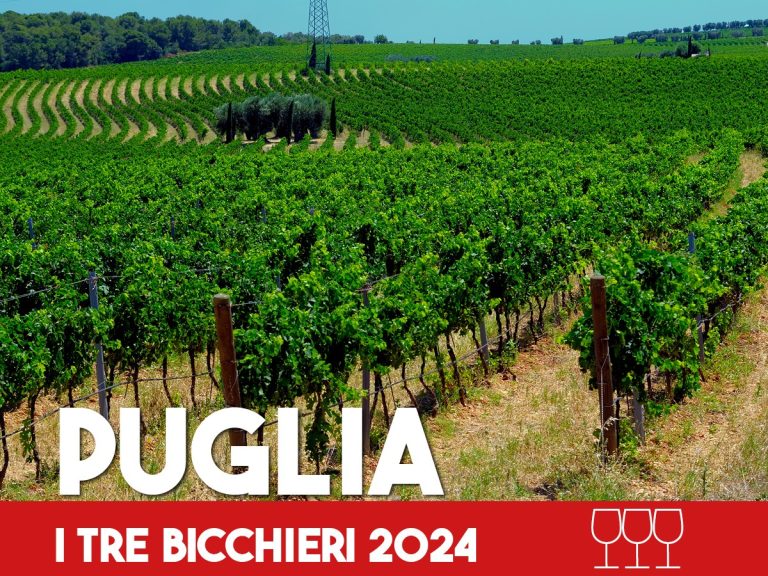Tre Bicchieri 2024 of Puglia
A. A. Chardonnay Kreuzweg Family Reserve 2019
A. A. Chardonnay V. Au Ris. 2019
A. A. Gewürztraminer Auratus 2022
A. A. Gewürztraminer Brenntal Ris. 2021
A. A. Gewürztraminer Nussbaumer 2021
A. A. Lago di Caldaro Cl. Sup. Quintessenz 2022
A. A. Lagrein Ris. 2020
A. A. Lagrein Taber Ris. 2021
A. A. Merlot Nussleiten Ris. 2019
A. A. Pinot Bianco Sanct Valentin 2021
A. A. Pinot Bianco Sirmian 2021
A. A. Pinot Grigio Giatl Ris. 2020
A. A. Pinot Nero Aton Ris. 2018
A. A. Pinot Nero Trattmann Ris. 2020
A. A. Santa Maddalena Cl. 2022
A. A. Sauvignon Lafóa 2021
A. A. Sauvignon Renaissance Ris. 2020
A. A. Terlano Pinot Bianco Abtei Muri Ris. 2020
A. A. Terlano Pinot Bianco Vorberg Ris. 2020
A. A. Val Venosta Riesling V. Windbichel 2021
A. A. Valle Isarco Grüner Veltliner Praepositus 2021
A. A. Valle Isarco Kerner Aristos 2022
A. A. Valle Isarco Sylvaner R 2021
Tre Bicchieri 2024 della Puglia. Identità e tipicità del territorio
It might seem paradoxical to speak of growth after the extremely challenging 2023 vintage, from which only a few producers are expected to achieve their desired results or even results comparable to those of previous years. However, it's inevitable to state: Puglia continues to grow, both in terms of quality and the awareness of this upward trajectory (and the ways to achieve it). One only needs to look at the appellation-designated wines honored with Tre Bicchieri (19) in comparison to those recognized just five years ago (10) to understand how the identity and uniqueness of the territory have become increasingly significant for the people of Puglia. This is a shift from merely a few years back when production was fundamentally tied more to the grape varietal than to the land. And this doesn't take into account some special instances, like Gianfranco Fino's Es, which hasn't held an appellation status for a few years now but certainly can't be relegated to being a "simple" primitivo, given that it screams Manduria with every sip.
This year, the Tre Bicchieri awards total 26, and we feel they aptly represent the high-quality standards maintained throughout the region. The stars of the show are the Primitivo di Gioia del Colle and the Primitivo di Manduria appellations (each with 7 awarded wines). Yet, there are also wines from Salice Salentino, Brindisi, Castel del Monte, and for the first time, a Terra d’Otranto has made a notable appearance.
We can only conclude, however, by touching on what some regard as our usual lament about the region’s "ultra-heavy" bottles. Once again, our tastings saw Puglia relying on a procession of wasteful glass—indeed, many bottles were actually cumbersome to handle due to their weight. As long as producers continue to use bottles that weigh up to 1200 grams, it seems entirely contradictory to then speak of sustainability, environmentally-conscious organic cultivation, and the like. The world has changed; Puglia should take note.


 Farewell cacio e pepe in New York. "With tariffs, Pecorino Romano will also become more expensive." The warning from Giuseppe Di Martino
Farewell cacio e pepe in New York. "With tariffs, Pecorino Romano will also become more expensive." The warning from Giuseppe Di Martino Against tariffs? Here are the US foods that could be "hit"
Against tariffs? Here are the US foods that could be "hit" US tariffs: here are the Italian wines most at risk, from Pinot Grigio to Chianti Classico
US tariffs: here are the Italian wines most at risk, from Pinot Grigio to Chianti Classico "With U.S. tariffs, buffalo mozzarella will cost almost double. We're ruined." The outburst of an Italian chef in Miami
"With U.S. tariffs, buffalo mozzarella will cost almost double. We're ruined." The outburst of an Italian chef in Miami "With US tariffs, extremely high risk for Italian wine: strike deals with buyers immediately to absorb extra costs." UIV’s proposal
"With US tariffs, extremely high risk for Italian wine: strike deals with buyers immediately to absorb extra costs." UIV’s proposal






